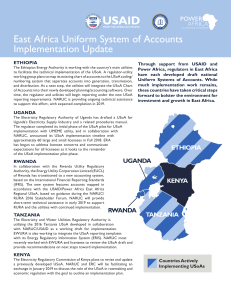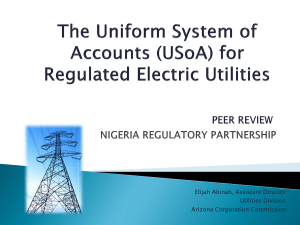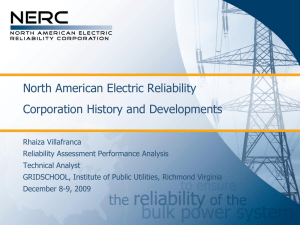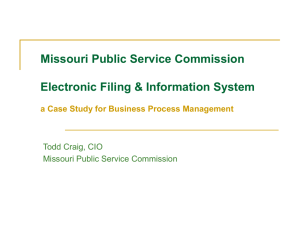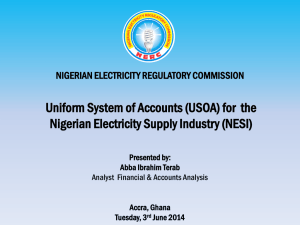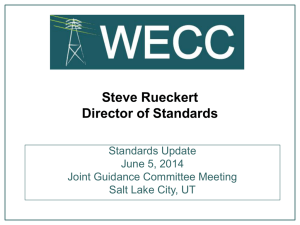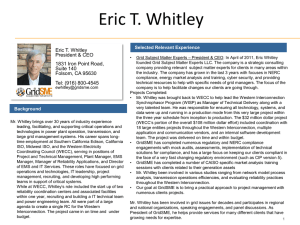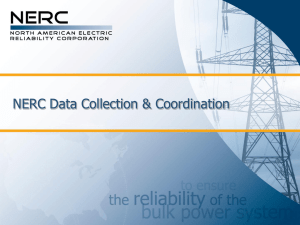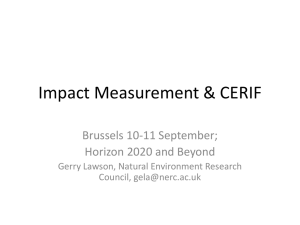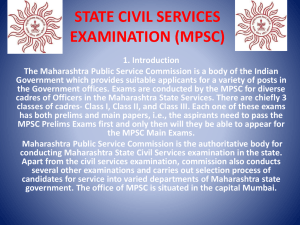Identifying the Barriers to Establishing a Uniform System of Accounts
advertisement
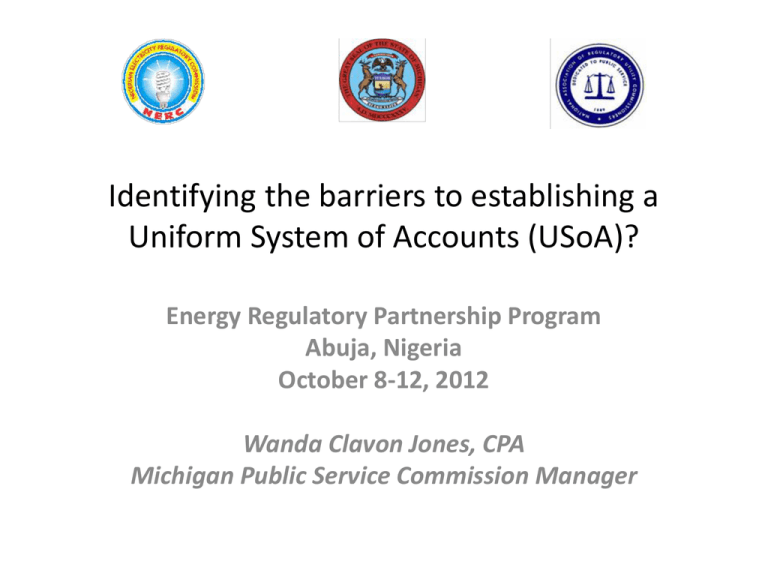
Identifying the barriers to establishing a Uniform System of Accounts (USoA)? Energy Regulatory Partnership Program Abuja, Nigeria October 8-12, 2012 Wanda Clavon Jones, CPA Michigan Public Service Commission Manager Discussion: what are the barriers to establishing the USoA? • Is there agreement at NERC that all the draft/proposed Nigerian USoA are necessary to implement at this time? • How is NERC proposing to implement the Nigerian USoA? • Will it be a phase-in process? • Will it be a certain date that all of it will be implemented by? • Are there reporting issues? • Are there enforcement issues? Discussion: was there a “buy-in” process or notice given to licensees regarding the USoA? • The purpose of a “buy-in” process is to give notice of changes to allow for better understanding and possible modifications. However, if there is no buy-in you still have the authority to implement and enforce. • What occurred during the a 3-day workshop: • How many licensees does NERC have? • How many licensees attended the conference? • Where licensees given an effective date USoA would go into effect? • If yes, was there a formal acknowledgement by the licensees that they received official notice? • NERC established a “Comment Period” however its my understanding that no comments were received? Is my understanding correct? • If yes, what was NERC planning to do had they received comments? • Since no comments were received, from NERC’s prospective are the USoA’s in effect? How Implementation the USoA Occurred at the MPSC • A Commission Order initiating generic proceeding and notice of hearing was issued • Within this Order, the following was established: • A time period is established for individuals wishing to intervene and become a party to the case shall file a petition to intervene • A date and time for a prehearing conference is established to grant intervention • Each regulated utility publish notice of this proceeding in newspapers of general circulation throughout its respective service territory • This becomes a contested case whenever anyone intervenes • A Commission Order would establish when the USoA would be implemented What is the purpose of the USoA? • The USoA establishes the accounting records that licensees must use for regulatory purposes • Such records assist in providing an adequate information base for establishing rates and monitoring licensees’ performance • The goal is to have focused accounting information relevant to economic regulation, which may at times differ from what is contained in statutory accounts, to enhance efficiency and transparency of the regulatory process • The USoA not only provides a uniform system of accounting for keeping and reporting of financial records by licensed utilities, but also requires accounting separation (also known as ring fencing) when the regulated entity has other businesses that the Commission does not regulate or as it may require to separate different activities within a regulated entity MPSC’s Contested Case Schedule • File application with the Commission • Prehearing • Staff and Intervener testimony filing date • Rebuttal testimony • Motions to strike • Responses to Motions • Cross examination • Initial Briefs • Reply Briefs • Proposal For Decision (PFD) • Exceptions to the PFD • Reply to the Exceptions • Commission Order What is the purpose of the USoA? continued • MPSC Uniform System of Accounts governs utility accounting for ratemaking purposes and serves as the basis for functionalizing costs, e.g., the USA requires utilities to record generating plant costs in accounts 310 359 and the associated O&M expense in accounts 500 - 557. These costs are directly assigned to the power supply function. • Because Michigan utilities have divested transmission plant, all that remains in the USA’s accounts designated for transmission are the plant costs associated with generator step up transformers. These costs are directly assigned to power supply. In addition, power supply includes the expense charged to account 565, “Transmission of Electricity by Others” including MISO charges. Categories of USoA • The Uniform System of Accounts has the following categories of costs: MPSC 100 Series Description Assets and other debits NERC 1000-1990 200 Series Liabilities and other credits 2000-2990 300 Series Electric plant accounts 3000-3990 400 Series (Same ) Income and revenue accounts 4000-4320, 4340-4350 4330, 4360-4390 4400-4590 Retained Earnings Accounts Revenue Accounts 500 Series Operations and maintenance 5000-5990 (Steam, Nuclear, Hydraulic, Other Power Generation, Transmission, & Distribution) 900 Series Administrative and General 9000-9480 NERC Statutory Authority • Section 62 of the Electric Power Sector Reform Act (2005) sets out that any person intending to engage in the business of electricity generation, transmission, system operation, distribution or trading shall be required to obtain an operator's license from the Commission. • The licensees issued by the Commission include conditions requiring the maintenance of records, the provision of information, and the separation of financial records between regulated and non-regulated activities, as stated by Sections 96(1) and 96(2)(f) of the Electric Power Sector Reform Act (2005). Specifically, Section 96(2)(f) empowers the Commission to make regulations that guarantee “the information that will be required from licensees and the manner and form it shall be provided”. NERC Statutory Authority continued • In accordance with the provisions of the Electric Power Sector Reform Act (2005), the Commission issued a reporting compliance regulation specifying the form and content of the accounting information required from the licensees with a view to facilitating the functions of tariff setting, monitoring and analysis of the financial health of the licensed utilities. • In order to ensure uniformity in the presentation of the accounting information, the Commission has decided to adapt the Uniform System of Accounts (USoA). MPSC Authority to Regulate • Act 3 of 1939 (MCL 460.6) vested with the PSC the power and jurisdiction to: • Regulate all public utilities in the state except a municipally-owned utility, the owner of a renewable resource power production facility, and except as otherwise restricted by law • Regulate all rates, fares, fees, charges, services, rules, conditions of service, and all other matters pertaining to the formation, operation, or direction of public utilities • Hear and pass upon all matters pertaining to, necessary, or incident to the regulation of public utilities MPSC Statutory Authority • Public Act 3 of 1939: Section 460.5a Description Outlines the Annual Report 460.6j (11) Power Supply Cost Recovery (PSCR) 45 Day Report (12) PSCR Reconciliation (Annual) (17) Exceptions regarding the Utilities who file Discussion: what types of items are covered in the operator’s license? • Does NERC have the statutory authority to enforce according to the license? • Does the license mandate the following: • Reporting requirements • Enforcement if requirements are not followed Alternative Electric Supplier (AES) Similarities • New issues for the MPSC • Reporting Requirements • Enforcements Issues • Reliability • Contract Cancellation AES’s Licensing Requirements: (set in Commission Order of U-11915) • Maintain an office within the state & provide a 24 hour toll-free phone number for customers • Maintain a $100,000 letter of credit or bond • Possess technical competence to engage in energy transactions • Meet safety requirements for electric operations • Ensure adequate service to Michigan customers • Maintain records as Commission considers necessary • Collect & remit all applicable taxes • Comply with all other lawful obligations Status of AES Programs Licensed AES: 23 • Consumers Energy Company • As of August 2012: • 788 MW • # of customers: 1,061 • Current active suppliers: 8 • Detroit Edison Company • As of August 2012: • 1,202 MW • # of customers: 5,734 • Current active suppliers: 10 • Indiana Michigan Power Company • As of August 2012: • 18.706 MW • # of customers: 70 • Current active suppliers: 4 • Upper Peninsula Power Company • As of August 2012: • 1.584 MW • # of customers: 1 • Current active suppliers: 1 Federal Energy Regulatory Commission (FERC) • FERC determinations may preempt MPSC decisions in certain areas • The FERC has jurisdiction over wholesale power markets and interstate power transactions • Any time power reaches the grid, the authority of the FERC comes into play • The MPSC’s authority extends to retail markets in Michigan. Discussion: Are there enough resources available for enforcement? • What reports/data does NERC want? • Annual reports? • Quarterly reports? • Is there enough staff to support the analysis of these reports? • What is the purpose of an audit? • What are the types of audits? • How does NERC Staff conduct an audit? • What is the proposed time period for the audit(s)? • What is the procedure going to be if the reports/data does not meet NERC’s standards? • How is NERC going to get the information they are requesting? 19 How Information & Data Flows Between the utilities and the MPSC • Formally, Utilities are required to submit reports to the MPSC such as: • Annual Reports (Report detailing the yearly financial activities of each utility) • 45-Day Reports (detail fuel and purchased power data from 45 days following the end of the preceding month) • Power Supply Cost Recovery plans and reconciliations • Summer Reliability assessments • Informally, Utilities provide the MPSC: • Audit requests spawning from contested cases • Customer and system interruption data. • Monthly fuel inventory levels • Other data and pertinent information as deemed necessary by the MPSC staff Discussion: Licensees • Do the Licensees have adequate staff to perform the analysis of the requested reports? • Do they understand what type of data NERC is looking for from these reports? Requested Deliverables: • • • • • • Regulatory Chart of Accounts (RCA) Regulatory Accounting Manual (RAM) Regulatory Reporting Template (RRT) Regulatory Audit Manual (RAM) Checklist and Evaluation Framework Training Materials – – Does NERC need a Consultant to ensure implementation of a uniform system of accounting? NERC was provided with a binder of various resources and a flash drive of additional deliverables, but a more in depth analysis is needed for the appropriate deliverables to be obtained.
